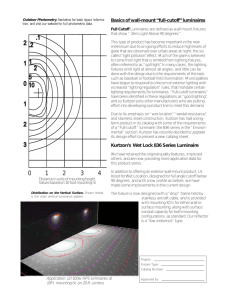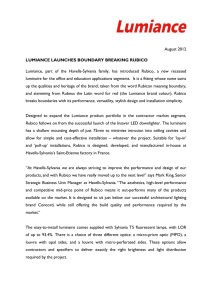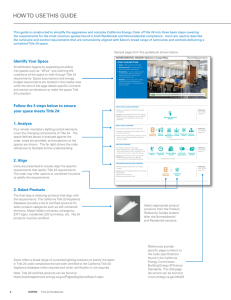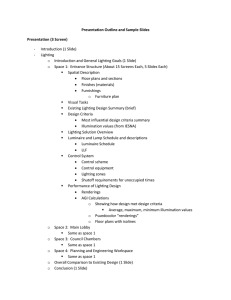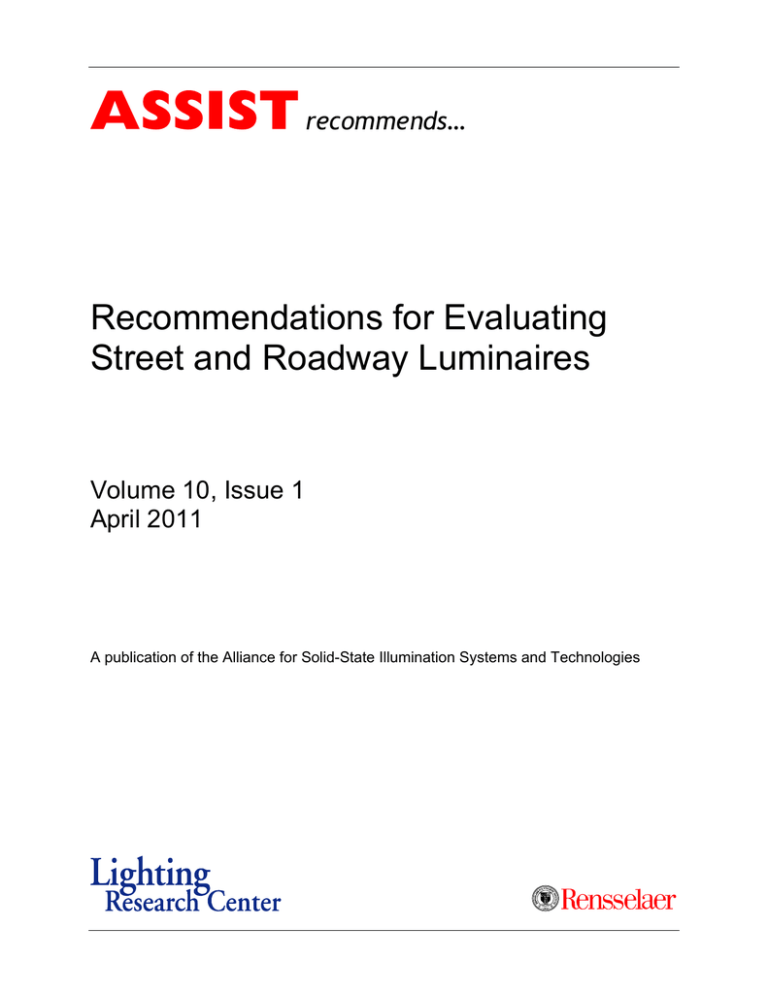
recommends…
Recommendations for Evaluating
Street and Roadway Luminaires
Volume 10, Issue 1
April 2011
A publication of the Alliance for Solid-State Illumination Systems and Technologies
recommends…
Copyright © 2011 by the Alliance for Solid-State Illumination Systems and Technologies
(ASSIST).
Published by the Lighting Research Center, Rensselaer Polytechnic Institute, 21 Union St.,
Troy, NY 12180, USA. Online at http://www.lrc.rpi.edu.
All rights reserved. No part of this publication may be reproduced in any form, print, electronic,
or otherwise, without the express permission of the Lighting Research Center.
ASSIST recommends is prepared by the Lighting Research Center (LRC) at the request of the
Alliance for Solid-State Illumination Systems and Technologies (ASSIST). The
recommendations set forth here are developed by consensus of ASSIST members and the
LRC. ASSIST and the LRC may update these recommendations as new research, technologies,
and methods become available.
Check for new and updated ASSIST recommends documents at:
http://www.lrc.rpi.edu/programs/solidstate/assist/recommends.asp
ASSIST Members
Acuity Brands Lighting
Lite-On
Amerlux Global Lighting Solutions
NeoPac Lighting
Bridgelux
New York State Energy Research and
Development Authority
China Solid State Lighting Alliance
OSRAM SYLVANIA / OSRAM Opto
Semiconductors
Cree
Everlight Electronics Co., Ltd.
Permlight
Federal Aviation Administration
Philips Lighting
GE Lighting Solutions
Seoul Semiconductor
ITRI, Industrial Technology Research
Institute
Sharp Laboratories of America
United States Environmental Protection
Agency
Intematix Corp.
LG Electronics
WAC Lighting
LG Innotek
Lighting Science Group
Lighting Research Center Technical Staff
Jean Paul Freyssinier, Leora Radetsky
2
recommends…
Contents
Introduction ................................................................................................................................................. 4
Background ................................................................................................................................................. 4
Definition of the Proposed Metric ............................................................................................................. 5
Defining the task plane ............................................................................................................................. 5
Range of Illuminance Values .................................................................................................................... 6
Penalizing non-conforming cells ............................................................................................................... 8
Evaluation method ...................................................................................................................................... 9
Luminaire System Application Efficacy (LSAE) ........................................................................................ 9
CCT, CRI, and Chromaticity ..................................................................................................................... 9
Glare and Uplight...................................................................................................................................... 9
Mesopic Characterization of Outdoor Lighting ....................................................................................... 10
Practicalities and utility ............................................................................................................................ 10
Optimum mounting height and pole spacing .......................................................................................... 10
Correlating LSAE to Energy Usage ........................................................................................................ 11
Summary .................................................................................................................................................... 11
References................................................................................................................................................. 12
Acknowledgments .................................................................................................................................... 13
About ASSIST............................................................................................................................................ 13
3
recommends…
Introduction
This document details a recommendation for evaluating the photometric
performance of street and roadway luminaires for all light source technologies.
The evaluation is based on an assessment of the effectiveness of luminaires at
meeting predetermined, application-based photometric criteria. The metric
described here is an extension of the work described in the publication ASSIST
recommends… Recommendations for Evaluating Parking Lot Luminaires (Vol. 7,
Iss. 3; ASSIST 2010) and is intended to be used as tool in the process of
selecting and rank ordering luminaire choices for a street lighting application.
This recommendation was developed by the Lighting Research Center (LRC) at
Rensselaer Polytechnic Institute in collaboration with members of the Alliance for
Solid-State Illumination Systems and Technologies (ASSIST). The suggested
audience for this document is luminaire manufacturers, street lighting designers
and specifiers, and luminaire purchase decision-makers.
Background
Well-designed, fixed street and roadway lighting is a valuable infrastructure
investment because it can provide social and economic benefits to the
community (Rea 2000). It is the result of careful consideration of many goals,
from helping the visual tasks of drivers and pedestrians, to energy conservation
and responsible environmental integration, to risk management and minimization
of potential obstacles in the path of drivers. From a lighting perspective, fixed
street and roadway lighting should provide sufficient light levels, uniformity, and
target contrast according to the type of road, and accommodate visual needs
under mesopic lighting conditions. The most common visual needs of drivers and
pedestrians include the identification of objects, obstacles and individuals in both
the direct field of view and in the periphery. Equally important is to minimize glare
(direct and reflected) and light pollution/trespass, and to make the appearances
of spaces appealing. It should have a low installation cost, consume as little
electric energy as possible, and require as little maintenance as possible, so as
to minimize the total cost of ownership. Thus, the effectiveness of a given lighting
system should be determined by how well the lighting goals are met while
considering the power and cost needed to achieve them, rather than judging only
the luminous efficacy of the light source or luminaire in absence of a context.
The photometric goals of street and roadway lighting are often summarized in
standards and recommended practices, among which the most common are
ANSI/IES American National Standard Practice for Roadway Lighting, RP-08-00
(IESNA 2000); BSI Road lighting. Performance requirements, BS EN 132012:2003 (BSI 2003); and CIE Lighting of Roads for Motor and Pedestrian Traffic,
CIE-115-2010 (CIE 2010). From the end-user’s point of view, it is important that
such recommendations are followed to help increase visibility. From the lighting
system owner’s point of view, it is important that the selected system meets the
photometric requirements of the application as effectively as possible, so that the
costs of operating the system are minimized. An effective system, one that meets
the application’s requirements with the fewest luminaires and lower total input
power, can reduce initial and operating costs. Traditional metrics used to
characterize light sources and luminaires in outdoor lighting applications include
luminous efficacy (lm/W), coefficient of utilization (CU; Rea 2000), luminous
efficacy rating (LER; NEMA 1999) and target efficacy rating (TER, NEMA 2008).
However, none of these metrics accounts for whether the target photometric
requirements of the specific application have been met. To provide a solution,
4
recommends…
ASSIST developed a metric (ASSIST 2010) that relates the ability of a luminaire,
or a system of several luminaires, to meet the photometric requirements of
specific applications. The metric, Luminaire System Application Efficacy (LSAE),
builds upon the concept of application efficacy, which was devised to evaluate
the delivery of light to where it is needed in the most energy-efficient manner.
Application efficacy was defined by Rea and Bullough (2001) as the average
luminous flux within a specific solid angle per unit of power. In its calculation,
LSAE includes only the light output that falls on the task plane, task, and that
meets the photometric requirements of the application’s task. LSAE initially was
developed and validated using criteria for parking lot applications, and different
analyses demonstrated that LSAE is a good predictor of energy efficiency,
whether it is used to rank individual luminaires, groups of luminaires, or a
complete application (ASSIST 2010, Narendran et al. 2010).
This document shows how LSAE can be adapted to requirements typical of
street and roadway lighting applications so that luminaires of different source
technologies can be compared on the same basis. The requirements used in the
metric presented here correspond to those in IESNA RP-8-00 and include
illuminance, illuminance uniformity ratios, and glare. It is worth noting that the
appropriateness of present outdoor lighting standards and recommended
practices is not being questioned or endorsed here; instead, the requirements
(e.g., illuminance, uniformity ratios, glare) are simply implemented into this metric
in their present form as an example of how LSAE can be adapted to meet preset
criteria. Similarly, it is worth emphasizing that the roadway LSAE metric
presented in this document is not meant to be a substitute for complete system
analysis. Other factors may influence the selection of light source and luminaire
options, such as cost, availability, spectral power distribution, life, etc.
Definition of the Proposed Metric
To address the issue of performance in street and roadway lighting applications,
LSAE is defined as the ratio of the luminous flux (in units of lumen) that falls on
the task plane and that meets the photometric requirements of the application
task, task-conforming, to the total input electrical power (in units of watt). Equation 1
shows the definition of LSAE.
LSAE = task-conforming ÷ P
(1)
By not including the light output falling beyond the task plane in the equation, the
luminaires that “waste” light by sending light outside the task plane are penalized.
Similarly, by not accounting for the luminous flux inside the task plane that does
not yield sufficient light levels, luminaires that do not provide expected light levels
throughout the task plane are also penalized. This approach leads to a more
“target-oriented” evaluation system that compares luminaires on their
effectiveness of delivering light for a specific application. The following sections
detail how the proposed LSAE is further refined to include the characteristics of
the task plane, the light level, uniformity, and glare requirements, and the
characteristics of the luminaire. For purposes of this document, the lighting
criteria in ANSI/IES American National Standard Practice for Roadway Lighting,
RP-08-00 is used as an example.
Defining the task plane
To determine the LSAE for a roadway application, the task plane is defined as
the area on the roadway between one luminaire cycle. The x-dimension of the
5
recommends…
task plane is the distance between luminaires in one luminaire cycle and is a
function of the luminaires’ intensity distribution, mounting height, luminaire
overhang dimension, pavement classification, and streetlight layout, as these
variables determine the maximum distance between poles so that RP-08-00
criteria are met. The y-dimension of the task plane is the travelway,
encompassing the travel lanes on the roadway. Figure 1 shows an example of a
staggered layout and indicates the x- and y-dimensions of the task plane.
The use of computer-based programs that optimize the pole spacing for a given
set of specific conditions (i.e., luminaire intensity distribution, mounting height,
overhang distance, roadway width and layout type) is highly recommended for
this and the following steps of the roadway LSAE calculation.
Figure 1: Task plane based on one luminaire cycle using a staggered luminaire layout. The ydimension is the travelway (including the roadway lanes but not the shoulder(s)).
Range of Illuminance Values
The RP-08-00 publication allows either illuminance- or luminance-based design
criteria to be used as a design method. Either method can be used to determine
the x-dimension of the task plane area; however, the illuminance values will be
used to calculate the LSAE values.
For the illuminance-based design criteria, RP-08-00 recommends a minimum
maintained average horizontal illuminance value that is based on the type of
road, pedestrian conflict area, and the pavement classification. The possible
combinations of the three variables yield 42 maintained average illuminance
criteria (Table 1). Within each of the six road classifications, there is a given
average-to-minimum illuminance uniformity ratio. For example, for a collector
road with medium pedestrian conflict having an “R3” asphalt surface, the
recommended minimum average maintained horizontal illuminance value is 0.9
fc (9.0 lx) and the average-to-minimum uniformity ratio is 4.0, from which a
minimum maintained horizontal value (Emin) of 0.23 fc (0.9 fc ÷ 4) can be
calculated. Notice that a maximum maintained horizontal illuminance value is not
given in RP-08-00. The LSAE calculation method uses the average illuminance
criterion and the average-to-minimum uniformity ratio criterion as the basis to
determine a luminaire’s effectiveness for the selected conditions. Therefore,
since a maintained average value is given, the LSAE calculation method
considers as wasteful any portion of the luminaire’s luminous flux that results in
more than the recommended minimum average or below the recommended
minimum. It is important to emphasize here that a light loss factor should be
included in the calculations, as the roadway lighting criteria is based on
maintained values (i.e., the lowest lighting levels on the roadway at the end of the
system’s service life).
6
recommends…
Table 1. IESNA recommended maintained average horizontal illuminance levels (lx) for
different types of roads, pavement, and pedestrian conditions (excerpt from IESNA 2000).
Road and Pedestrian Conflict Area
Pedestrian
conflict area
Road
Freeway Class A
Freeway Class B
Expressway
Major
Collector
Local
Pavement Classification
Uniformity
ratio
Veiling
luminance
ratio
R1
R2 & R3
R4
Eavg / Emin
Lvmax / Lavg
6 lx
9 lx
8 lx
3.0
0.3
4 lx
6 lx
5 lx
3.0
0.3
High
10 lx
14 lx
13 lx
3.0
0.3
Medium
8 lx
12 lx
10 lx
3.0
0.3
Low
6 lx
9 lx
8 lx
3.0
0.3
High
12 lx
17 lx
15 lx
3.0
0.3
Medium
9 lx
13 lx
11 lx
3.0
0.3
Low
6 lx
9 lx
8 lx
3.0
0.3
High
8 lx
12 lx
10 lx
4.0
0.4
Medium
6 lx
9 lx
8 lx
4.0
0.4
Low
4 lx
6 lx
5 lx
4.0
0.4
High
6 lx
9 lx
8 lx
6.0
0.4
Medium
5 lx
7 lx
6 lx
6.0
0.4
Low
3 lx
4 lx
4 lx
6.0
0.4
Once the task plane dimensions have been determined with the RP-08-00
lighting design criteria (either illuminance or luminance-based), a calculation grid
with 2 ft by 2 ft (0.6 m by 0.6 m) cells is created for one luminaire cycle and the
corresponding illuminance values are calculated (Figure 2).
Figure 2: Calculation grid created for one luminaire cycle once the maximum pole spacing has
been determined per RP-08-00 (IESNA 2000).
This grid is used to estimate the luminous flux falling within each cell of the grid
by conducting a simple calculation based on the definition of illuminance, E,
where E is equal to the luminous flux () divided by the area of incidence.
Because the area of each grid cell (Areacell = 2.0 ft × 2.0 ft = 4.00 ft2) and the
illuminance at the center of each grid cell (Ecell) are known, it is possible to
estimate the luminous flux reaching each cell (cell; Equation 2).
cell = Ecell × Areacell
7
(2)
recommends…
Penalizing Non-conforming Cells
Once the illuminance values are calculated in the task plane, the next step is to
determine which of those values do not contribute to achieving the target
illuminance and uniformity criteria because they are too low or to high. Because
the target illuminance criteria in RP-08-00 are a minimum (Emin) and an average
(Eavg) value, those two values are used to determine which cells should be
penalized. First, all the illuminance values are sorted in ascending order. This
step can be accomplished more easily by exporting the illuminance values
calculated in lighting design software into a spreadsheet. Second, all illuminance
values lower than Emin are declared non-conforming and discarded from the
analysis. Third, from the remaining set of illuminance values (i.e., those that are
equal to or higher than Emin), an average is calculated by adding one value to the
calculation at a time until it equals the minimum maintained average illuminance
given in RP-08-00. Once the minimum maintained average illuminance for the
given roadway is met, any remaining illuminance values in the calculation grid
are no longer used for the analysis. These discarded values are considered to be
non-conforming because they effectively raise the average illuminance over the
value required in RP-08-00 and thus can be considered wasteful. Finally, each
illuminance value counted toward the minimum maintained average illuminance
is converted into luminous flux using Equation 2 and is considered the only
“useful” or “conforming” light reaching the task plane. Notice that the uniformity
and glare criteria are already met when the pole spacing is determined following
the RP-08-00 procedure (i.e., using several luminaire cycles) and that for this
step only one luminaire cycle is considered and needed.
It is worth noting also that the 2 ft by 2 ft (0.6 m by 0.6 m) illuminance grid
recommended for calculating LSAE is more dense than the grid specified in RP08-00, which may lead to illuminance values closest to the curbline being lower
than the minimums allowed in RP-08-00. These illuminance values are
considered to be non-conforming and are not included in the calculation of
“useful” luminous flux for LSAE (see step 2 in the above paragraph). Also,
because of the lower illuminance values closest to the curbline, the dense 2 ft by
2 ft illuminance grid may have an average illuminance lower than the minimum
maintained average illuminance given in RP-08-00. Any of these situations that
may arise during the LSAE calculation should not be construed as reasons to
claim that the design does not meet RP-08-00 criteria.
In cases where the streetlight layout has been designed to meet the RP-08-00
luminance-based criteria, the average illuminance may be lower than that
required if the illuminance design method was selected instead. In these cases,
all of the illuminance values equal or higher than Emin are converted to luminous
flux in the LSAE calculation.
Contribution of adjacent luminaires
In cases where the roadway lighting layout is not single-sided (e.g., the lighting
layout uses a staggered or opposite streetlight arrangement), the “useful”
luminous flux derived from the conforming cells has to be divided in half because
in each luminaire cycle, more than one streetlight is contributing light toward the
task plane.
8
recommends…
Evaluation Method
Luminaire System Application Efficacy (LSAE)
Generally speaking, the evaluation process for LSAE includes four major steps.
The first step is to obtain an accurate and representative measurement of the
intensity distribution of the luminaire under evaluation. The second step is to
determine the task plane dimension by calculating the maximum pole spacing at
which the lighting criteria are met for the desired pole layout. The third step is to
create a grid on the task plane and calculate the illuminance values at each
point. The fourth step is to calculate the LSAE based on the conforming
illuminance values and the input power of the luminaire.
CCT, CRI, and Chromaticity
For traditional technologies (e.g., HID, fluorescent and incandescent), it is
common practice to report the lamp CCT, CRI, and CIE x,y values as provided
by the lamp manufacturer or testing laboratory. For LED luminaires, the IESNA
LM-79-08 approved method calls for testing the photometric and colorimetric
properties of the complete luminaire using the absolute photometry method
(IESNA 2008).
Glare and Uplight
Light radiating at high vertical angles (approximately 75° to 80°) from a street or
roadway luminaire can potentially cause glare, although in many situations it is
possible to create glare from light at lower angles (e.g., 60°). Glare is a critical
issue in area, street and roadway luminaire design, due to the high luminous
intensity required for illuminating a large area at night. Designers may need to
look at the luminous flux exiting a luminaire at a certain angle (the glare zone),
the luminaire mounting height, and visually adjacent luminaires to evaluate the
potential for glare in a particular situation (NLPIP 2004, 2007). The lighting
design criteria in RP-08-00 takes into consideration glare, and this plays an
important role in the calculation of pole spacing for a given set of conditions,
including the luminaire’s intensity distribution, mounting height, type of pavement,
etc.
Also, the uplight portion (light that extends to angles greater than 90°) from the
luminaire can be considered a waste of light and can contribute to light pollution.
More information can be obtained from the IESNA’s TM-15-07 Luminaire
Classification System for Outdoor Luminaires (IESNA 2007a) and the companion
document Addendum A for IESNA TM-15-07: Backlight, Uplight and Glare (BUG)
Ratings (IESNA 2007b).
The present document does not directly address glare and light pollution
because those issues are contextual; thus, specific information about the
application in which the luminaire is used is needed. Additional information and
evaluation tools can be found in two methods of predicting light pollution and
glare from outdoor lighting installations that the Lighting Research Center has
published. The first is a comprehensive method for predicting and measuring the
three aspects of light pollution, called the Outdoor Site-Lighting Performance
method (Brons et al. 2008). The second is a simple, quantitative model to predict
discomfort glare from outdoor lighting installations (Bullough et al. 2008, ASSIST
2011).
9
recommends…
Mesopic Characterization of Outdoor Lighting
Recent research into how the eye “sees” under mesopic conditions and the
development of an alternative, unified system of photometry support the possible
trade-off between light source spectrum and light level for light sources used in
nighttime, outdoor applications (Rea et al. 2004). ASSIST has published step-bystep instructions for calculating the unified luminance of a given light source
based on light level and the scotopic-to-photopic ratio of the light source.
Different combinations of light sources and light levels may produce the same
unified luminance, which indicates photometric equivalency. Therefore, the
system can serve as a simple method for trading off light sources and light levels
under mesopic conditions, and thereby aid in the selection of light sources for a
given application. For more information, see ASSIST recommends…Outdoor
Lighting: Visual Efficacy (ASSIST 2009) and IESNA’s TM-12-06, Spectral Effects
of Lighting on Visual Performance at Mesopic Light Levels (IESNA 2006).
Practicalities and Utility
Optimum Mounting Height and Pole Spacing
The roadway LSAE value is specific to the conditions used in its calculation. Most
notably, the LSAE value of a luminaire is linked to the mounting height used to
determine the pole spacing. Thus, for a given pole layout and roadway geometry,
it is possible to calculate LSAE systematically as a function of mounting height.
Generally, the optimum mounting height for a luminaire (the mounting height that
yields the maximum LSAE) also yields the maximum pole spacing. With this
information available, designers can narrow the selection of luminaires that most
likely fit in the application at hand (e.g., if they are required to use a specific
mounting height) and fine-tune their design. As an example, Figure 3 shows the
LSAE values for a sample luminaire at various mounting heights. The data labels
above each marker indicate the maximum pole spacing to meet RP-08-00 at that
mounting height. This particular luminaire has an optimum mounting height of 25
ft for the road width used in the calculations and provides a spacing of 195 ft
between luminaires and an LSAE equal to 32 lm/W.
40
195 ft
167 ft
174 ft
LSAE (lm/W)
30
153 ft
130 ft
20
10
65 ft
0
10
15
20
25
30
35
40
45
Mounting height (ft)
Figure 3. LSAE values and pole spacing for various mounting heights for a sample luminaire in
a staggered layout.
10
recommends…
Correlating LSAE to Energy Usage
LSAE is a useful tool to predict energy use for roadway lighting installations.
Table 2 and Figure 4 show a comparison of six commercially available
luminaires. The analysis shows the LSAE values for these luminaires in a
staggered configuration at their optimum mounting height. This mounting height
provides the maximum pole spacing possible to meet RP-08-00 for a collector
road with medium pedestrian conflict that is 48-ft wide with four lanes. Using the
maximum pole spacing, the number of streetlights in a staggered layout over a
one-mile length of roadway was determined, and the power demand per linear
mile (kW/mile) was calculated. Table 2 summarizes the characteristics of the
luminaires and the results. Figure 4 shows power demand per mile as a function
of LSAE. The plotted LSAE values show a high correlation between higher LSAE
and lower power demand values, which means that LSAE values can be used to
compare and rank order luminaires in terms of energy efficiency.
Table 2. Streetlight characteristics and LSAE results for six commercially available streetlights
used to light a one-mile length of collector road to RP-08-00 (IESNA 2000) lighting criteria.
Sample
Mounting
height (ft)
Pole spacing
(ft)
Input power
(W)
LSAE
(lm/W)
# poles / mile
Power demand
(kW/mile)
1
30
135
204
13.9
77
15.8
2
30
120
174
14.9
87
15.1
3
25
90
144
13.4
116
16.8
4
35
215
305
15.1
48
14.7
5
40
190
293
13.6
55
16.0
6
40
165
290
12.2
63
18.3
20
Power demand (kW per mile)
y = -1.1863x + 32.524
2
R = 0.9596
18
16
14
12
10
10
11
12
13
14
15
16
LSAE (lm/W)
Figure 4. Power demand along a one-mile length of collector road that meets RP-08-00 (IESNA
2000) as a function of LSAE.
Summary
Luminaire System Application Efficacy (LSAE) measures luminaire efficacy for a
luminaire in an application with preset criteria, including absolute illuminance
values, uniformity ratios, and glare, at a given mounting height and pole spacing.
11
recommends…
LSAE is a technology-neutral, application-specific metric that can be adapted to
multiple standard recommendations.
Although the LSAE value is reported for one luminaire, its calculation includes
the effects of contributing luminaires. LSAE provides a number that is specific to
the mounting height, optical characteristics, and light output of a given luminaire
such that designers can determine the conditions under which the luminaire will
perform best at meeting the given photometric criteria. With this information, a
designer can choose the best luminaire for the given application or rank order a
number of products. LSAE values for a given luminaire change depending on the
application, but a higher LSAE value will ensure the application has appropriate
light levels to meet the application’s need with a lower power demand.
References
Alliance for Solid-State Illumination Systems and Technologies (ASSIST). 2009.
ASSIST recommends…Outdoor Lighting: Visual Efficacy. Vol. 6, Iss. 2.
Troy,
N.Y.:
Lighting
Research
Center.
Internet:
http://www.lrc.rpi.edu/programs/solidstate/assist/recommends/parkinglot.
asp.
Alliance for Solid-State Illumination Systems and Technologies (ASSIST). 2010.
ASSIST recommends… Recommendations for Evaluating Parking Lot
Luminaires. Vol. 7, Iss. 3. Troy, N.Y.: Lighting Research Center. Internet:
http://www.lrc.rpi.edu/programs/solidstate/assist/recommends/parkinglot.
asp.
Alliance for Solid-State Illumination Systems and Technologies (ASSIST). 2011.
ASSIST recommends…A Method for Estimating Discomfort Glare from
Exterior Lighting Systems. Vol. 9, Iss. 1. Troy, N.Y.: Lighting Research
Center.
Internet:
http://www.lrc.rpi.edu/programs/solidstate/assist/recommends/discomfort
glare.asp.
British Standards Institute (BSI). 2003. Road lighting. Performance requirements,
BS EN 13201-2:2003. London: BSI.
Brons, J.A., J.D. Bullough, and M.S. Rea. 2008. Outdoor site-lighting
performance: A comprehensive and quantitative framework for assessing
light pollution. Lighting Research and Technology 40(3): 201–224.
Bullough, J.D., J.A. Brons, R. Qi, and M.S. Rea. 2008. Predicting discomfort
glare from outdoor lighting installations. Lighting Research and
Technology 40(3): 225–242.
Commission Internationale de l’Éclairage (CIE). 2010. Lighting of Roads for
Motor and Pedestrian Traffic, CIE 115:2010. Vienna: CIE.
Illuminating Engineering Society of North America (IESNA). 2000. American
National Standard Practice for Roadway Lighting, RP-8-00. New York:
IESNA.
Illuminating Engineering Society of North America (IESNA). 2006. Spectral
Effects of Lighting on Visual Performance at Mesopic Light Levels. TM12-06. New York: IESNA.
12
recommends…
Illuminating Engineering Society of North America (IESNA). 2007a. IES TM-1507 Luminaire Classification System for Outdoor Luminaires. New York:
IESNA.
Illuminating Engineering Society of North America (IESNA). 2007b. Addendum A
for IESNA TM-15-07: Backlight, Uplight and Glare (BUG) Ratings. New
York:
IESNA.
Internet:
http://www.ies.org/PDF/Erratas/TM-1507BUGRatingsAddendum.pdf.
Illuminating Engineering Society of North America (IESNA). 2008. Approved
Method: Electrical and Photometric Measurements of Solid-State
Lighting Products. LM-79-08. New York: IESNA.
National Lighting Product Information Program (NLPIP). 2004. Specifier Reports:
Parking Lot and Area Luminaires. Troy, N.Y.: Lighting Research Center.
Internet: http://www.lrc.rpi.edu/nlpip/publicationDetails.asp?id=900&type=1.
National Lighting Product Information Program (NLPIP). 2007. Lighting Answers:
Light Pollution. Troy, N.Y.: Lighting Research Center. Internet:
http://www.lrc.rpi.edu/nlpip/publicationDetails.asp?id=884&type=2.
Narendran, N., J.P. Freyssinier, J. Taylor, T. Dong, and R. Capó. 2010.
Application efficacy for comparing energy demand in lighting
applications. Tenth International Conference on Solid State Lighting,
August 1- 5, 2010, San Diego, CA, Proceedings of SPIE 7784: 77840L.
National Electrical Manufacturers Association (NEMA). 1999. Procedure for
Determining Luminaire Efficacy Ratings for Commercial Non-Residential
Downlight Luminaires. Publication LE 5A-1999, Rosslyn, VA: NEMA.
National Electrical Manufacturers Association (NEMA). 2008. Procedure for
Determining Target Efficacy Ratings for Commercial, Industrial, and
Residential Luminaires. Publication LE 6-2008, Rosslyn, VA: NEMA.
Rea, M.S. (ed.). 2000. IESNA Lighting Handbook: Reference and Application, 9th
Edition. New York: Illuminating Engineering Society of North America.
Rea, M.S. and J.D. Bullough. 2001. Application efficacy. Journal of the
Illuminating Engineering Society 30(2): 73–96.
Rea, M.S., J.D. Bullough, J.P. Freyssinier-Nova, and A. Bierman. 2004. A
proposed unified system of photometry. Lighting Research and
Technology 36(2): 85–111.
Acknowledgments
ASSIST and the Lighting Research Center would like to thank the following for
their review and feedback during the development of this publication: Philips
Hadco.
About ASSIST
The Alliance for Solid-State Illumination Systems and Technologies (ASSIST)
was established in 2002 by the Lighting Research Center as a collaboration
between researchers, manufacturers, and government organizations. ASSIST’s
mission is to facilitate broad adoption of solid-state lighting by helping to reduce
major technical and market barriers.
13

